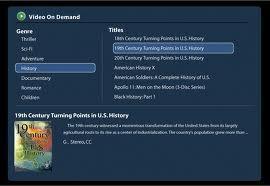VOD (Video on Demand)
Video on Demand is the term used for the system by which content providers allow their users to request visual and/or audio content and serve that content to their users, in contrast to programming that is established in advance which the user cannot control. VOD can also be referred to as AVOD (Audio Video on Demand).
Most Video on Demand services allow the user fine control over the requested content, including pausing it, reviewing previously viewed content (also called “rewinding”), advancing through it (also called “fast-forward”), as well as slow-motion versions of rewind and fast-forward. These functions are sometimes called “trick modes.”
Typical providers of Video on Demand are cable, telephone companies, and other broadband providers that supply traditional network and cable television programming. Some airlines also provide VOD to their customers through video screens embedded in seat backs or fold-out arm rests.
Video on Demand requires that the user have special equipment on their premises for the viewing of this content. The provider’s back end hardware communicates with the user’s hardware: typically, a television set-top box which includes the provider’s television-tuning capabilities. The back end sends pieces of the content to the user’s box, which then manipulates it per the request of the user.
Frequently, theater films and special performances such as sporting events are provided through VOD services at an extra cost to the consumer.
VOD Competitors
Similar technologies to VOD are NVOD (Near Video on Demand) and Push VOD.
Near Video on Demand is not an interactive system. Cable companies and other content providers broadcast the content at staggered time intervals. Customers can order a film or other content and view it within a few minutes, depending on the system their provider has in place. However, the viewer has no control over the playback of the content.
Push VOD depends upon the customer having a device, commonly referred to as a PVR (Personal Video Recorder) or DVR (Digital Video Recorder), which can record the content from the provider’s network for later playback.


Comments - No Responses to “VOD (Video on Demand)”
Sorry but comments are closed at this time.